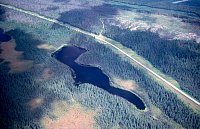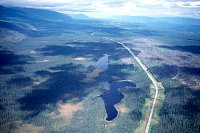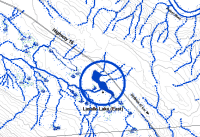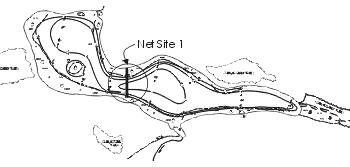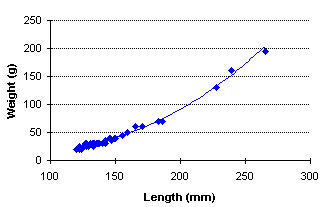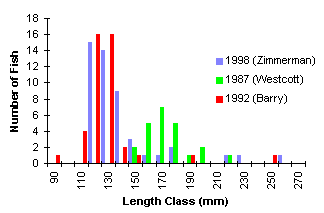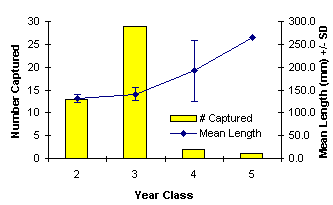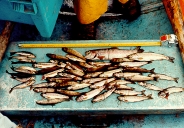 |
|||||
|
Recreational Fishery
Introduction This report presents the results of a stock assessment of La Salle Lake East completed by Ted Zimmerman and Don Cadden on May 19, 1998. La Salle Lake East is a small 12.5 ha lake located approximately 47 km west of McBride , and was initially stocked with rainbow trout in 1988. This assessment follows up on previous surveys conducted in 1992 and 1987 , and was implemented partially due to concerns expressed by the angling community in the Robson Valley, and as part of a region-wide stock assessment program in 1998.
Methods
An experimental, 91.2m sinking monofilament gill net was set in La Salle Lake East on May 19,1998 according to the methods prescribed in the Resource Inventory Committee document Fish Collection Methods and Standards . The net was deployed at 2:05 PM and retrieved the same day at 4:25 PM, for a total soak time of 2 hours, 20 minutes. The net was set in a NE-SW direction from the east shore, approximately 250 m south of the access trail from Hwy. 16 (Figure 2) . The net ranged in depth from the surface to approximately 5.5 m. All trout captured were sampled for fork
length , weight, sex, and maturity. Scale
samples were taken from all rainbow trout, and were sent to
Darlene Gillespie
of TimeMark Consulting (Nanaimo, B.C.) for ageing and returned
to the Ministry for analysis.
Results
CATCH SUMMARY
The net catch yielded 49 rainbow trout (RB), for a catch
per unit effort of 20.9 RB per net-hour. No fish were captured
in the deepest three net panels. Only 7 fish were positively identified
as females; all other fish sampled were classified as "immature"
or "unknown." See Appendix
1 for individual rainbow trout sample data.
ANALYSIS Condition The weight of La Salle Lake East rainbow trout increased according
the equation W = 2E-5 x L2.896, where W = weight in
grams and L = length in mm. This relationship is expressed in
Figure 3. There were no anomolies noted amongst the fish
sampled, and in general the fish appeared healthy for their respective
size. Size Distribution The length-frequency distribution of rainbow trout captured in
1998 was similar to that reported in 1992, with the majority of
the population falling in the 120 to 140 mm size range (Figure
4). This finding differs from the sample collected in 1987,
which consisted of slightly larger fish distributed between 160
to 180 mm. Age and Growth The rainbow trout in La Salle Lake East consisted primarily of age 3 individuals (Figure 5), with 2-year-olds also well represented. Age 4 and 5 trout were present in the sample, however their numbers were low. The growth of the population is very slow, with age 3 fish attaining a mean length of only 140 mm and a mean weight of 34 g. This represents only a 9 mm average increase in size from the 2-year-old year cohort. These findings are concurrent with those reported in the 1992 survey.
Discussion and Management Recommendations The rainbow trout of La Salle Lake East can be characterized as an abundant but very slow growing population, currently dominated by small, 120 to 140 mm fish. The population has not exhibited any appreciable change in its size class composition since 1992, suggesting that current stocking levels and/or lake conditions are producing a stunted and static population structure.
According to a 1987 lake inventory, the Total Dissolved Solids (a measure of lake productivity) in La Salle East is 68 mg/L. The adjacent La Salle Lake (West), which currently produces a viable brook trout fishery, contains 109 mg/L of TDS. The relatively low TDS observed in La Salle East may therefore reflect a lower overall productive potential and may explain the stunted growth rates observed in our sample. An equally plausible explanation for the observed growth rate is that the lake is receiving too many fish, either directly through hatchery releases or through wild recruitment, or a combination of both. La Salle East did have a viable, wild population of rainbow trout prior to stocking (Figure 4, 1987 data), although this population also exhibited a slow growth rate. While on site we conducted a cursory examination of the inlet and outlet, and both systems were deemed unuseable for spawning or rearing, suggesting that natural recruitment is unlikely. While some habitat may have been missed during this survey, the complete absence of mature fish in our sample supports the argument that recruitment is limited at best in La Salle East. An additional complicating factor is that of ageing error. The age results from the 1998 sample indicate that the population consists primarily of the 1995 cohort, yet no fish of that age class were stocked in La Salle East. Several of the fish were identified as "3 plus," indicating that additional circuli were identified from the last annulus to the scale's edge, a finding that would not be expected for fish sampled early in the season. If natural recruitment is indeed occurring in the lake, then perhaps these fish do in fact represent the 1995 cohort. Otherwise they should be classified as the 1994 cohort, and the growth rate illustrated in Figure 5 should be adjusted downward accordingly. In conclusion, the 1987 data shows that prior to stocking, La Salle Lake East produced somewhat larger fish than those observed in our sample, but not large enough to provide a satisfactory recreational fishery. The data further suggests that, since the inception of stocking, the mean size of rainbow trout has diminished even further. It is likely that low lake productivity combined with high levels of stocking have contributed to the very slow growth rates of rainbow trout. In light of this information, the scheduled stocking release
for 1999 was suspended in order to allow natural mortality to
reduce the density of fish in La Salle East. The stocking program
is scheduled to recommence in 2000, at a reduced rate of 1000
large yearlings stocked in alternate years. A reassessment should
be conducted in 2002 to ascertain whether this decision has resulted
in improved growth rates and a satisfactory recreational fishery.
Literature Cited Barry, S. 1992. A stocking assessment of
La Salle Lake (East). Ministry of Environment, Lands and Parks.
Prince George.
For More Information: Contact :Ted Zimmerman
|
|||||||||||||||||||||||||||||||||||||||||||
